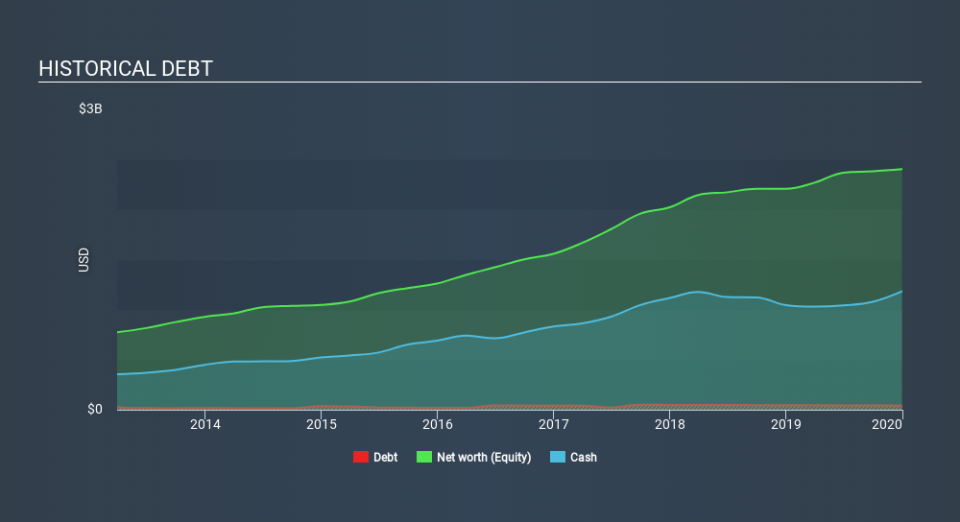Is IPG Photonics (NASDAQ:IPGP) A Risky Investment?

Legendary fund manager Li Lu (who Charlie Munger backed) once said, 'The biggest investment risk is not the volatility of prices, but whether you will suffer a permanent loss of capital. So it might be obvious that you need to consider debt, when you think about how risky any given stock is, because too much debt can sink a company. Importantly, IPG Photonics Corporation (NASDAQ:IPGP) does carry debt. But is this debt a concern to shareholders?
When Is Debt Dangerous?
Debt is a tool to help businesses grow, but if a business is incapable of paying off its lenders, then it exists at their mercy. Ultimately, if the company can't fulfill its legal obligations to repay debt, shareholders could walk away with nothing. However, a more usual (but still expensive) situation is where a company must dilute shareholders at a cheap share price simply to get debt under control. Of course, plenty of companies use debt to fund growth, without any negative consequences. The first step when considering a company's debt levels is to consider its cash and debt together.
Check out our latest analysis for IPG Photonics
How Much Debt Does IPG Photonics Carry?
As you can see below, IPG Photonics had US$41.7m of debt at December 2019, down from US$45.4m a year prior. However, its balance sheet shows it holds US$1.18b in cash, so it actually has US$1.14b net cash.
How Healthy Is IPG Photonics's Balance Sheet?
According to the last reported balance sheet, IPG Photonics had liabilities of US$191.9m due within 12 months, and liabilities of US$136.1m due beyond 12 months. Offsetting this, it had US$1.18b in cash and US$248.1m in receivables that were due within 12 months. So it can boast US$1.10b more liquid assets than total liabilities.
This excess liquidity suggests that IPG Photonics is taking a careful approach to debt. Given it has easily adequate short term liquidity, we don't think it will have any issues with its lenders. Simply put, the fact that IPG Photonics has more cash than debt is arguably a good indication that it can manage its debt safely.
The modesty of its debt load may become crucial for IPG Photonics if management cannot prevent a repeat of the 44% cut to EBIT over the last year. When it comes to paying off debt, falling earnings are no more useful than sugary sodas are for your health. There's no doubt that we learn most about debt from the balance sheet. But ultimately the future profitability of the business will decide if IPG Photonics can strengthen its balance sheet over time. So if you're focused on the future you can check out this free report showing analyst profit forecasts.
Finally, a business needs free cash flow to pay off debt; accounting profits just don't cut it. While IPG Photonics has net cash on its balance sheet, it's still worth taking a look at its ability to convert earnings before interest and tax (EBIT) to free cash flow, to help us understand how quickly it is building (or eroding) that cash balance. Over the most recent three years, IPG Photonics recorded free cash flow worth 51% of its EBIT, which is around normal, given free cash flow excludes interest and tax. This cold hard cash means it can reduce its debt when it wants to.
Summing up
While it is always sensible to investigate a company's debt, in this case IPG Photonics has US$1.14b in net cash and a decent-looking balance sheet. So we are not troubled with IPG Photonics's debt use. The balance sheet is clearly the area to focus on when you are analysing debt. However, not all investment risk resides within the balance sheet - far from it. To that end, you should be aware of the 2 warning signs we've spotted with IPG Photonics .
Of course, if you're the type of investor who prefers buying stocks without the burden of debt, then don't hesitate to discover our exclusive list of net cash growth stocks, today.
If you spot an error that warrants correction, please contact the editor at editorial-team@simplywallst.com. This article by Simply Wall St is general in nature. It does not constitute a recommendation to buy or sell any stock, and does not take account of your objectives, or your financial situation. Simply Wall St has no position in the stocks mentioned.
We aim to bring you long-term focused research analysis driven by fundamental data. Note that our analysis may not factor in the latest price-sensitive company announcements or qualitative material. Thank you for reading.

 Yahoo News
Yahoo News 

